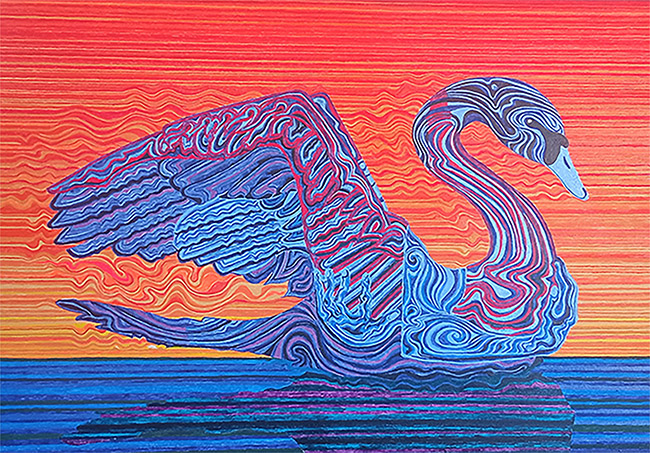Frederick Haddox is an American-born expressionist artist living in Budapest, Hungary. He works with acrylics on canvas, blending human and animal forms in a style that evokes the unseen forces connecting us all. His approach to art is grounded in creating an atmosphere based on color, line, and form, straying from traditional composition. Haddox’s work is about capturing energy and transforming it into something visual, a narrative that speaks through shapes and hues rather than through realistic depictions or fixed scenes.

In a piece like Dusk, Haddox has crafted a moment of transition, a quiet but powerful reflection on the subtle vibrational shifts that happen as the day ends. Measuring 100 by 70 cm, the work stands out not only for its size but for its impactful composition. Dusk captures the stillness that settles over the natural world at day’s end, suggesting a kind of pause before night takes hold. Straight lines and subdued currents dominate the landscape, emphasizing a sense of calm. Yet, when these lines intersect with a swan, crafted from intertwining human forms, a subtle disruption takes place. This swan figure—emerging from lines and colors that flow like water and air—seems to pulse with a unique energy, suggesting that human presence can stir even the quietest corners of the natural world.
Haddox sees vibrational energy as a force that can be sensed, if not always seen. His lines and colors interact to suggest different states of being or emotional atmospheres. By merging human and animal forms, Haddox reflects on the blurred line between ourselves and the world around us. He’s interested in how our energies interact with and change our surroundings. For him, art is a bridge that connects two worlds—the visible and the invisible. Haddox invites viewers to question where their energy starts and ends, using his works as a space to explore this continuous exchange.
Born in the United States, Haddox’s journey to Budapest allowed him to tap into the European art scene, which has a long-standing tradition of experimentation with form and color. Budapest has offered him a blend of classic and contemporary influences that enrich his expressionist approach. Haddox takes his inspiration from this cultural melting pot, mixing it with his own ideas to develop a language that speaks to people across boundaries.
In his broader portfolio, Haddox continues to explore how abstract forms can tell stories. His canvases don’t follow predictable paths or fixed scenes; instead, they feel fluid, alive with the movement of line and color. Rather than constructing realistic landscapes, he uses expressive strokes to suggest forms that feel both familiar and elusive. Animals and humans often coexist, their shapes melting into each other as if they’re part of a shared, vibrant tapestry.
Another theme in Haddox’s work is time’s passage and how it influences energy. He believes that certain times of day carry unique vibrational qualities. Dawn and dusk, moments of transition, play a special role in his art. These times seem to hold an almost mystical quality, where the energy is neither completely dormant nor fully awakened. In Dusk, Haddox brings this feeling to life by showing how straight, seemingly still lines in the water shift subtly upon contact with the swan—a moment of awakening in an otherwise still world.
Haddox’s work demands a different kind of viewing experience. To really appreciate his art, it helps to step back and view it from a distance, letting the colors and shapes work their magic. Close up, you’ll find details that speak to his technique—the fluidity in his brushwork, the careful balance of bold and soft lines, and his sensitivity to color. But it’s only when you view the piece as a whole that the narrative truly unfolds, revealing something abstract yet powerful.
This narrative approach makes Haddox’s work appealing to a wide range of viewers, from those who find meaning in color to those intrigued by the blend of human and animal forms. He doesn’t aim to impose an interpretation; rather, he invites viewers to experience the energy of his work and take from it what they feel. In this way, his paintings become a mirror of sorts, reflecting each person’s unique perspective.
Though Haddox may be influenced by expressionists before him, he has carved out his own path, one that centers on the concept of vibrational energy. His works may not follow the rules of traditional art, but they pulse with life, inviting viewers to consider their connection to the world around them. In Dusk and beyond, Haddox’s art continues to explore the unseen, bridging divides between animal and human, stillness and movement, and form and energy.
For those looking to experience something beyond the surface, Frederick Haddox’s work offers a contemplative journey through color, line, and form, a visual language all its own.

